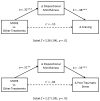Mindfulness-Oriented Recovery Enhancement versus CBT for co-occurring substance dependence, traumatic stress, and psychiatric disorders: Proximal outcomes from a pragmatic randomized trial
- PMID: 26701171
- PMCID: PMC4752876
- DOI: 10.1016/j.brat.2015.11.012
Mindfulness-Oriented Recovery Enhancement versus CBT for co-occurring substance dependence, traumatic stress, and psychiatric disorders: Proximal outcomes from a pragmatic randomized trial
Erratum in
-
Corrigendum to "Mindfulness-oriented recovery enhancement versus CBT for co-occurring substance dependence, traumatic stress, and psychiatric disorders: Proximal outcomes from a pragmatic randomized trial" [Behav. Res. Ther. 77 (2016) 7-16].Behav Res Ther. 2018 Jan;100:78. doi: 10.1016/j.brat.2017.09.007. Epub 2017 Sep 28. Behav Res Ther. 2018. PMID: 28964403 No abstract available.
Abstract
In many clinical settings, there is a high comorbidity between substance use disorders, psychiatric disorders, and traumatic stress. Novel therapies are needed to address these co-occurring issues efficiently. The aim of the present study was to conduct a pragmatic randomized controlled trial comparing Mindfulness-Oriented Recovery Enhancement (MORE) to group Cognitive-Behavioral Therapy (CBT) and treatment-as-usual (TAU) for previously homeless men residing in a therapeutic community. Men with co-occurring substance use and psychiatric disorders, as well as extensive trauma histories, were randomly assigned to 10 weeks of group treatment with MORE (n = 64), CBT (n = 64), or TAU (n = 52). Study findings indicated that from pre-to post-treatment MORE was associated with modest yet significantly greater improvements in substance craving, post-traumatic stress, and negative affect than CBT, and greater improvements in post-traumatic stress and positive affect than TAU. A significant indirect effect of MORE on decreasing craving and post-traumatic stress by increasing dispositional mindfulness was observed, suggesting that MORE may target these issues via enhancing mindful awareness in everyday life. This pragmatic trial represents the first head-to-head comparison of MORE against an empirically-supported treatment for co-occurring disorders. Results suggest that MORE, as an integrative therapy designed to bolster self-regulatory capacity, may hold promise as a treatment for intersecting clinical conditions.
Keywords: Addiction; Emotion regulation; Mindfulness; PTSD; Reappraisal; Savoring; Transdiagnostic.
Copyright © 2015 Elsevier Ltd. All rights reserved.
Conflict of interest statement
Figures
References
-
- Baer RA, Smith GT, Hopkins J, Krietemeyer J, Toney L. Using self-report assessment methods to explore facets of mindfulness. Assessment. 2006;13:27–45. - PubMed
-
- Baker TB, Piper ME, McCarthy DE, Majeskie MR, Fiore MC. Addiction motivation reformulated: an affective processing model of negative reinforcement. Psychological Review. 2004;111:33–51. - PubMed
-
- Boden MT, Bonn-Miller MO, Kashdan TB, Alvarez J, Gross JJ. The interactive effects of emotional clarity and cognitive reappraisal in posttraumatic stress disorder. Journal of Anxiety Disorders. 2012;26(1):233–238. - PubMed
-
- Bryant FB, Veroff J. Savoring: A new model of positive experience. Lawrence Erlbaum Associates Publishers; 2007. Retrieved from http://psycnet.apa.org/psycinfo/2006-11872-000.
Publication types
MeSH terms
Grants and funding
LinkOut - more resources
Full Text Sources
Other Literature Sources
Medical



